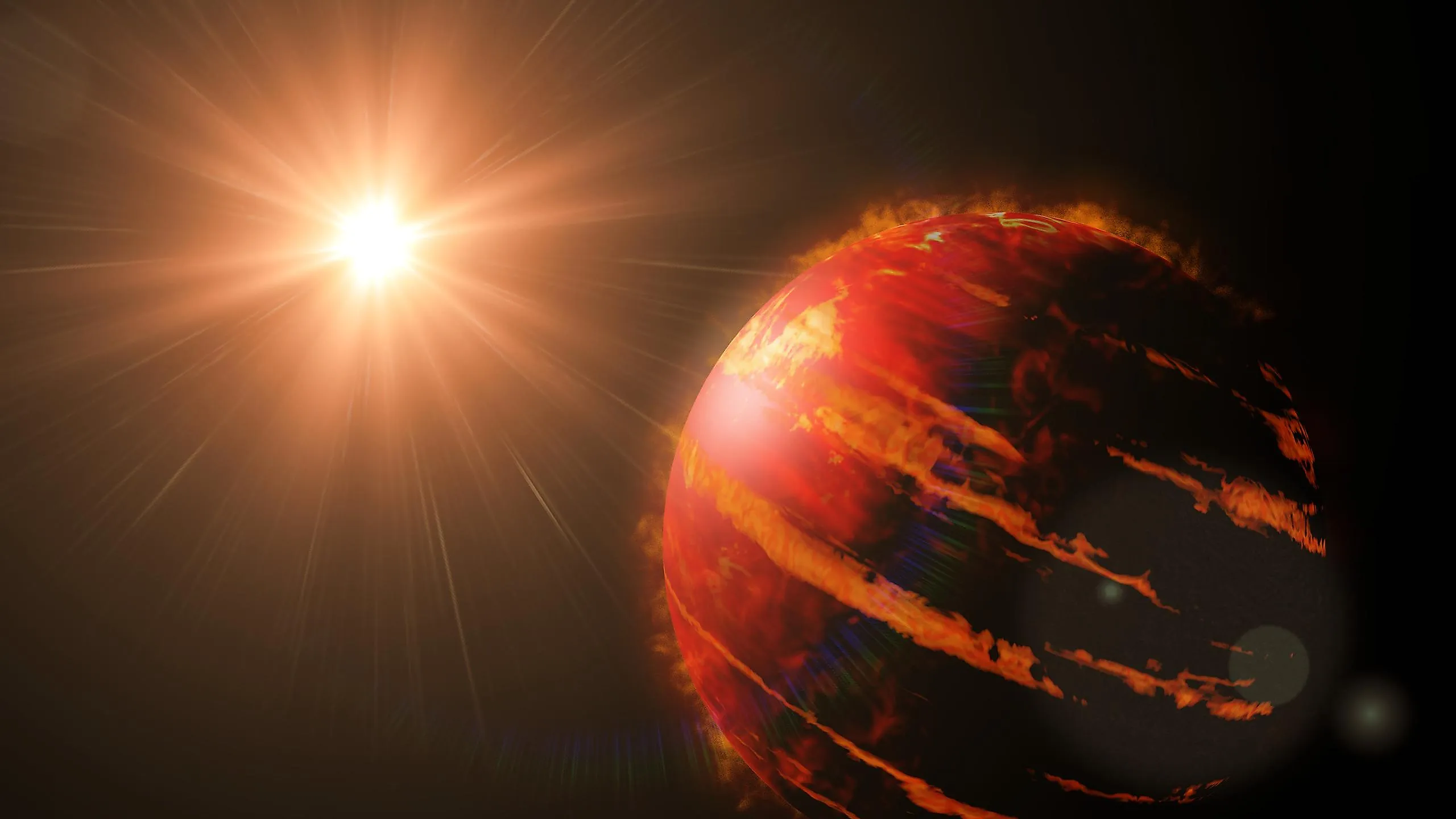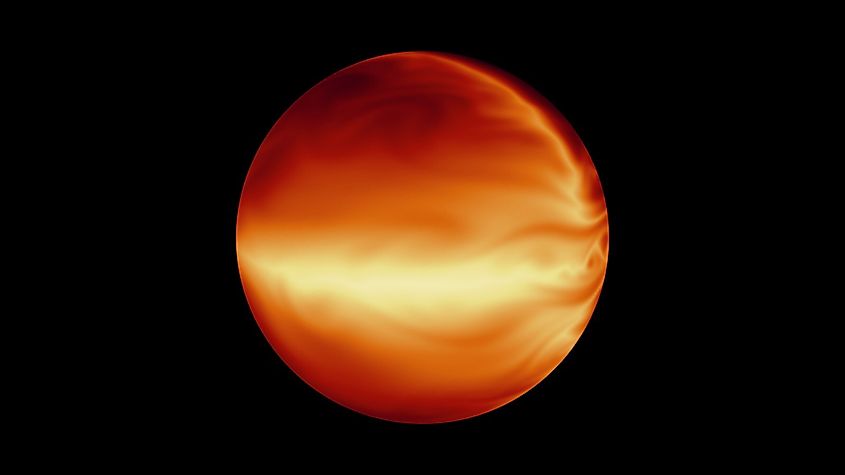
What Is A Hot Jupiter?
Our solar system is home to three different types of planets: rocky, gas giant, and ice giant. Interestingly, these only represent some of the different types of planets that exist in the universe. Hot Jupiters are one type of planet that cannot be found in our solar system. The first exoplanet discovered was a hot Jupiter called 51 Pegasi b. This newly discovered world belonged to an entirely new class of planets that stunned and confused scientists. Based on our solar system and models of its formation, astronomers had long believed that gas giants could only exist in the outer regions of a solar system. When a star forms, bursts of energy tend to push lighter elements further away from the star. Because these elements exist in a much higher abundance, you end up with gas giants primarily made of hydrogen and helium orbiting in the outer regions of a solar system. However, 51 Pegasi b forced scientists to rethink this entire model. 51 Pegasi b was a gas giant like Jupiter, yet it orbited its star at a distance closer than Mercury does to our sun. 51 Pegasi b was an entirely new kind of planet that astronomers appropriately named “hot Jupiter.” Their discovery led to an entirely new model of both orbital dynamics and planet formation.
How Does A Planet Become A Hot Jupiter?

The discovery of 51 Pegasi b had poked a hole in models of planet formation, yet astronomers soon devised a new model that helped explain this anomaly. Called planet migration, this new model suggested that gas giants do, in fact, form in the outer regions of a solar system. Yet, over time, they can migrate towards the inner areas. Most gas giants likely experience some form of migration in their early years, even the gas giants in our solar system. It is now believed that none of the gas giants in our solar system orbit where they formed. Instead, Neptune likely formed closer to the Sun than Uranus, and Jupiter and Saturn likely formed much farther than their current orbits. Over time, Neptune and Uranus swapped places. Jupiter is believed to have started migrating towards the inner solar system, and there was a good chance that Jupiter could have become a hot Jupiter. Thankfully for us, the gravitational pull of Saturn stopped Jupiter from moving closer to the sun and pulled it back into its current orbit.
Notable Hot Jupiters
Hot Jupiters are some of the most common types of planets discovered, many of which are unlike anything in our solar system. 51 Pegasi b was the first hot Jupiter discovered and is also one of the most interesting. What would it be like to visit 51 Pegasi b? Although technology is limited in determining the environment of exoplanets, there are some interesting theories about the environment on 51 Pegasi b. Located 50 light-years away, 51 Pegasi b is about half the mass of Jupiter and has an estimated surface temperature of 1,733 degrees Fahrenheit (945 degrees Celsius). Because it orbits so close to its star, it moves tremendously fast, having an average orbital velocity of 304,223 miles per hour (136 km/s) and completing one orbit every 4.2 days. Although it is half the mass of Jupiter, it is likely much larger in size. The heat from its star super-heats its atmosphere, causing it to puff up and expand. At such a high temperature, most of the planet likely glows red, and it may even have clouds made of vaporized rock.
Another notable hot Jupiter, designated as WASP-12b, is truly an alien world. It orbits extremely close to its star at a distance of only 2.1 million miles (3.4 million kilometers). For comparison, Mercury orbits the sun at an average distance of 41 million miles (66 million kilometers). With such a small distance between WASP-12b and its parent star, it takes a mere one day to complete a full orbit. Extreme gravitational forces have distorted the planet’s shape, making it appear more egg-shaped than circular. Average temperatures are estimated to be a scorching 3,992 degrees Fahrenheit (2,200 degrees Celsius). Yet, perhaps the most exciting aspect of WASP-12b is the fact that it absorbs 94% of the light that hits it. If you were to visit this hot Jupiter, it would be as dark as asphalt. Observations from Hubble have also revealed that its parent star is currently consuming WASP-12b, and in the next 10 million years or so, the planet will be destroyed entirely.
Have you ever imagined what it would be like to visit a world with winds blowing at 5,405 miles per hour (8,700 km/h) and molten glass for rain? Whether you’ve imagined such a hellish world or not, look no further than the hot Jupiter designated as HD 189733 b. This hot Jupiter is even larger and more massive than Jupiter, having a mass 13% larger than Jupiter’s. With an orbital period of only 2.2 days, it moves at a speed of 340,014 miles per hour (152 km/s). Amazingly, HD 189733 b was the first exoplanet that astronomers managed to generate a thermal map of. This allowed them to determine its temperature, over 1,472 degrees Fahrenheit (800 degrees Celsius), its color (deep blue), and part of its composition, finding evidence of carbon dioxide in its atmosphere. Perhaps the most exciting aspect about this planet is that its temperature and composition suggest it rains molten glass. HD 189733 b is definitely a world you want to see from a distance.
Not only was a hot Jupiter the first exoplanet to be found using the radial velocity method, but they were also the first to be discovered using the transit method. HD 209458 b is a hot Jupiter discovered in 1999 using the transit method. Nicknamed Osiris, its orbital radius is a mere 4.3 million miles (seven million kilometers), resulting in an orbital period of only 3.5 days. At such a close distance to its parent star, Osiris experiences temperatures of over 1,832 degrees Fahrenheit (1,000 degrees Celsius). The discovery of Osiris and later observations represented many firsts for exoplanet detection. It was the first exoplanet to have an atmosphere discovered, and perhaps most interesting, Osiris was the first exoplanet for which astronomers discovered evidence of weather and storms. At around 70% of the mass of Jupiter, the extreme heat from its star along with gravitational tidal forces have caused the gas giant to swell, making it 35% larger than Jupiter.











